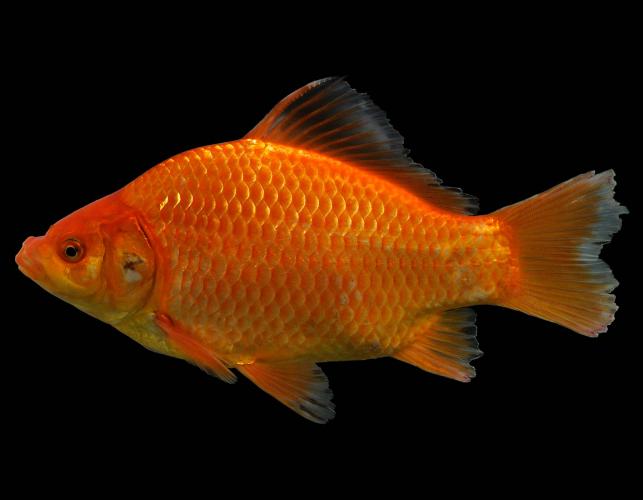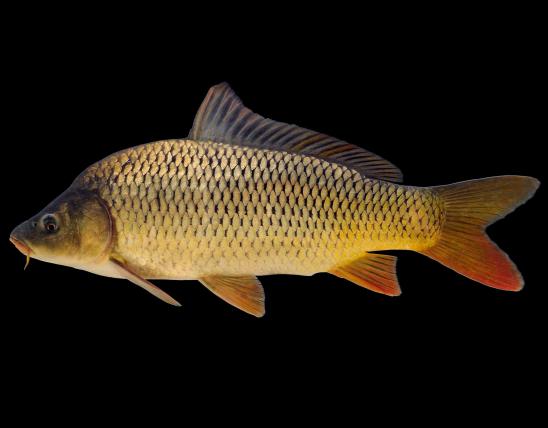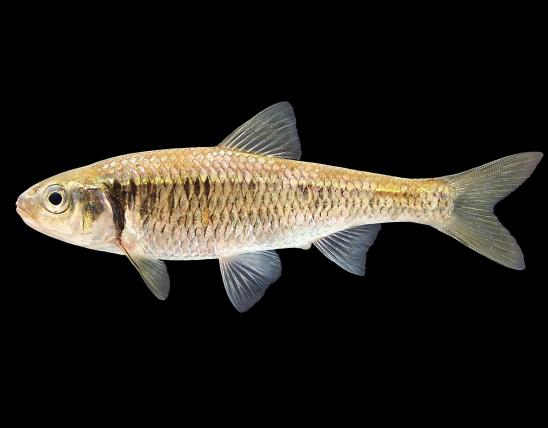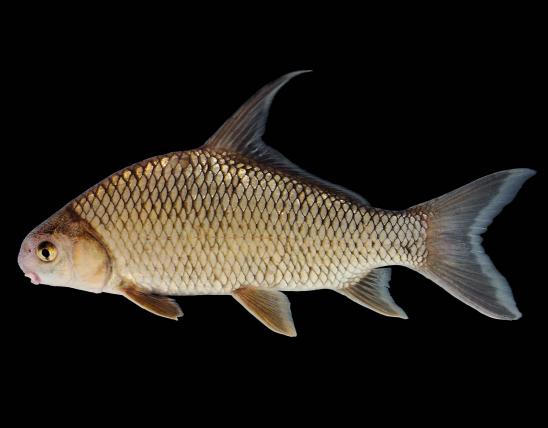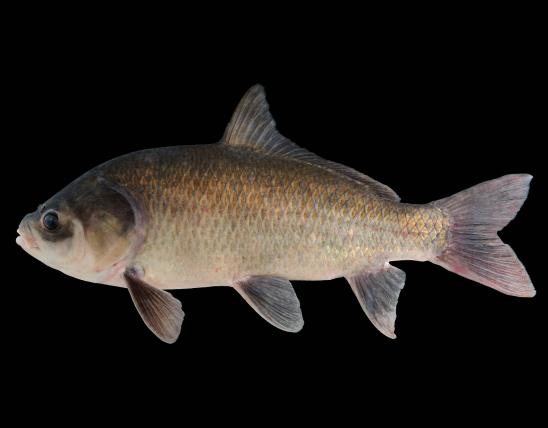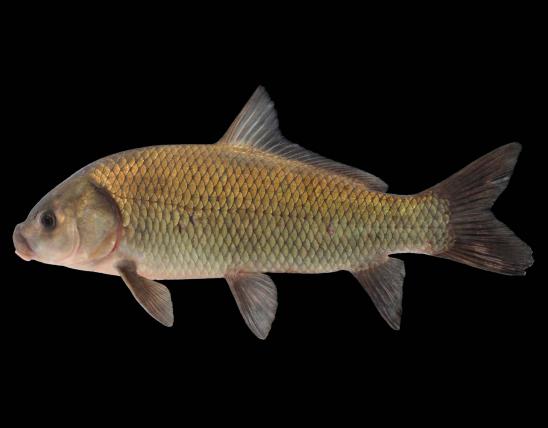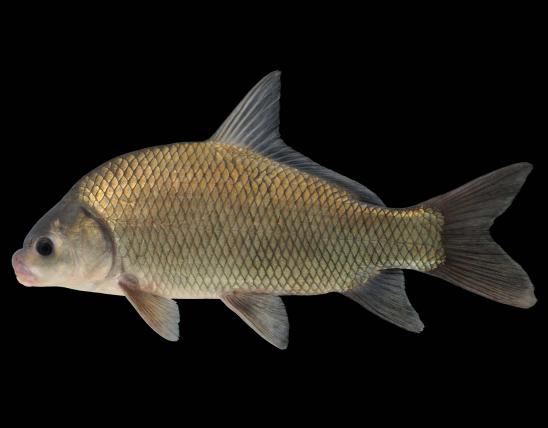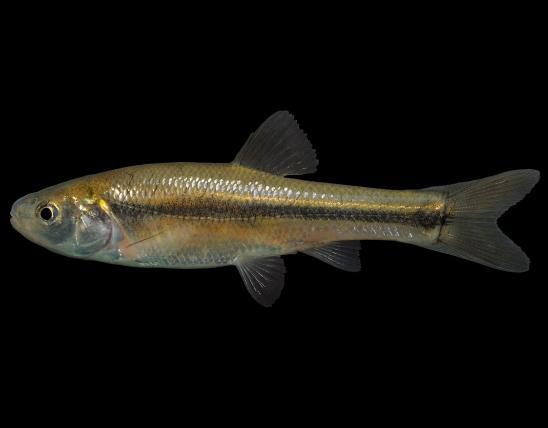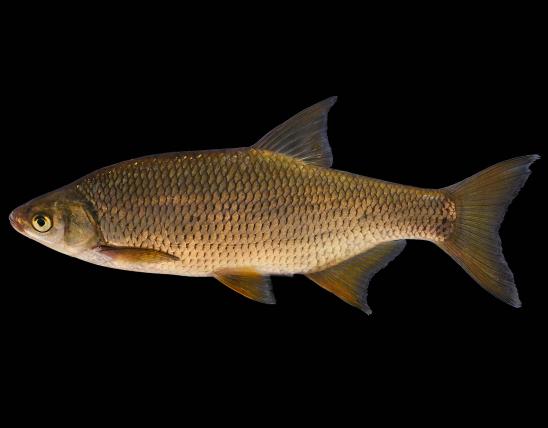
Goldfish are not native to North America. They often escape into the wild from bait buckets and other causes, but there are few self-sustaining populations in Missouri.
The goldfish resembles the common carp in having a long dorsal fin and a stout, saw-toothed spine at the front of the dorsal and anal fins. However, the goldfish lacks barbels on the corners of the mouth, and there are fewer than 30 scales in the lateral line. Also, the throat teeth are in a single row of 4-4 and lack extensive grinding surfaces. Over centuries, aquarists have bred goldfish to have a variety of rounded body shapes, fan tails, protruding eyes, and so on, but the ones most likely to be found surviving in natural waters are the plainer “bait fish” types with flatter bodies and simple fins.
Colors may vary. Most people are familiar with the cultured varieties of goldfish we see at aquarium shops, which may be orange (“gold”), white, red, black, or combinations of these colors. “Wild” type goldfish are dark olive-brown above, shading to yellow on the lower sides and belly. The scales are not prominently dark-edged as they are in the common carp.
The goldfish can be distinguished from other Missouri minnows by the following:
- The dorsal and anal fins each have a stout, saw-toothed spine at the front.
- The dorsal fin is long, with more than 15 principal rays.
- The upper jaw lacks barbels (unlike the common carp, which has them on each side of the jaw).
- Lateral line scales number 26–29.
Similar species: There are about 70 species of minnows recorded in Missouri. The goldfish and common carp can be separated from all the rest by the longer dorsal and anal fins and the presence of a stout, saw-toothed spine at the front of those fins. Buffalofishes and carpsuckers (in a different family) have elongated dorsal fins, but they lack the stout saw-toothed spines at the front.
Habitat and Conservation
The goldfish is native to east Asia, so, like the common carp, it is not native to the United States. No largescale attempts have been made to establish the goldfish in Missouri, but the thousands that are released or escape from hatcheries, bait buckets, artificial lakes, and home aquaria have afforded ample opportunity for its establishment. Yet there seem to be few self-sustaining populations of goldfish in natural waters of the state.
In Missouri, the only established populations of goldfish are in natural standing-water habitats along streams. Most other records are from streams below hatcheries, where goldfish numbers are maintained by frequent escape, and in large impoundments, where goldfish are commonly used as bait. Otherwise, little pattern exists to this fish’s distribution, and occasional individuals may be encountered almost anywhere in the state.
A substantial population has been recorded in Rose Pond, in Clark County. Another established population apparently exists in a scour hole along the Missouri River in Lafayette County. Goldfish have also been found in Jerry P. Combs Lake, in Dunklin County.
Food
Status
Life Cycle
Human Connections
Over 1,000 years ago, the Chinese were breeding carp and goldfish for bright colors and interesting body shapes. Apparently, it started as fish farming for food, but as individuals with interesting colors appeared, those were selectively bred for increasingly vibrant colors. Chinese nobility had special ponds built in their courtyards for these special fish.
In the early 1600s, goldfish keeping was introduced to Japan and Europe, where the hobby quickly became popular. Goldfish keeping was introduced into North America in the mid-1800s. Today, of course, many people enjoy having outdoor fish ponds and indoor aquaria, and this supports a pet store trade as well as a subset of the landscaping industry.
Goldfish used in outdoor ponds tend to be the plainer, hardier types, while goldfish in aquariums may be quite fancy, with butterfly or veil tails, egg-shaped bodies, telescoping or bubble eyes, inflated bubble-like tissues on the top of the head, and so on. Several fancy varieties lack the dorsal fin entirely. In east Asian countries and internationally, goldfish breeding is taken very seriously, with breed guidelines, major shows and competitions, and awards for spectacular individual specimens.
Beginning aquarists soon learn that goldfish are quite different from the other fish at the pet store, almost all of which are from tropical regions. Goldfish, however, are “coldwater fish,” native to temperate, not tropical climates. Their preferred temperature is 68 to 72 F — lower than the temperatures needed for tropical fish. Because of several water chemistry factors and their own coldwater metabolism, goldfish are one of the worst kinds of pet fish to keep in a “fishbowl” or any other small aquarium.
Goldfish farming has been an industry in Missouri, with most of the goldfish produced being sold as bait fish to anglers, or “feeder fish” sold in pet stores as food for large, piscivorous (fish-eating) fish. Along these lines, carnivals sometimes give away bagged goldfishes as prizes.
Because they can be kept in captivity, goldfish have been studied quite a bit by scientists. Much is known about their behavior; how they sense their environment through vision and hearing; how they think; and how they interact with each other and reproduce.
Ecosystem Connections
Goldfish are not native to our continent and should never be released into natural waters. Never release any aquarium fish or plants into the wild. Goldfish have no place in our native ecosystems.
The goldfish is considered invasive in some states and nations. In some places, goldfish have shown a potential to survive and produce large populations and thus compete with, or even prey on the eggs of, native species. Also, large populations of goldfish can alter the water quality, the way common carp do, by their digging and rooting into the substrate, which clouds the water and dislodges vegetation. Additionally, goldfish can potentially transmit parasites and bacterial infections to native fish species and even some frogs.
Aquarium keeping is a great way to learn about fishes and aquatic biology, aquatic nutrient cycles, fish behavior, and much more. An aquarium is basically a small-sized model of an aquatic habitat. Many people start with a pet goldfish, then move on to tropical fish and increasingly larger aquaria. The knowledge aquarists gain is very helpful for understanding how natural ecosystems work. And with understanding comes informed decisions about how to care for our environment — which can have a huge and positive impact on our ecosystems.
